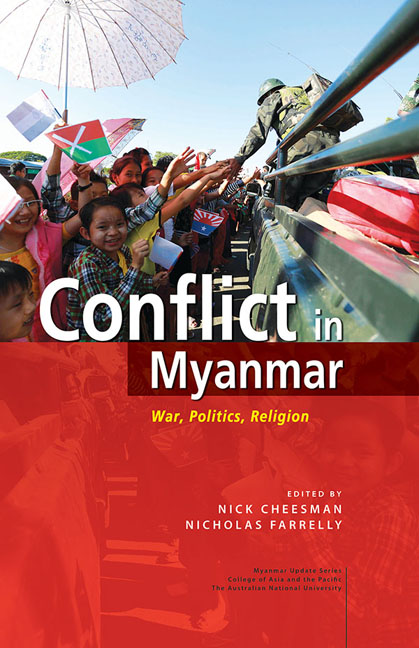Book contents
- Frontmatter
- Contents
- List of Maps
- List of Tables
- List of Figures
- Acknowledgements
- Contributors and Editors
- Part I Introduction
- Part II War and Order
- Part III Elections and After
- Part IV Us and Them
- 12 Making sense of reactions to communal violence in Myanmar
- 13 Public perceptions of a divided Myanmar: Findings from the 2015 Myanmar Asian Barometer Survey
- 14 On Islamophobes and Holocaust deniers: Making sense of violence, in Myanmar and elsewhere
- 15 Buddhist welfare and the limits of big ‘P’ politics in provincial Myanmar
- 16 Threat perceptions in the Myanmar–Bangladesh borderlands
- Part V Conclusion
- Abbreviations and Key Terms
- Index
14 - On Islamophobes and Holocaust deniers: Making sense of violence, in Myanmar and elsewhere
from Part IV - Us and Them
Published online by Cambridge University Press: 22 July 2017
- Frontmatter
- Contents
- List of Maps
- List of Tables
- List of Figures
- Acknowledgements
- Contributors and Editors
- Part I Introduction
- Part II War and Order
- Part III Elections and After
- Part IV Us and Them
- 12 Making sense of reactions to communal violence in Myanmar
- 13 Public perceptions of a divided Myanmar: Findings from the 2015 Myanmar Asian Barometer Survey
- 14 On Islamophobes and Holocaust deniers: Making sense of violence, in Myanmar and elsewhere
- 15 Buddhist welfare and the limits of big ‘P’ politics in provincial Myanmar
- 16 Threat perceptions in the Myanmar–Bangladesh borderlands
- Part V Conclusion
- Abbreviations and Key Terms
- Index
Summary
The theme for the Australian National University (ANU) 2015 Myanmar Update Conference was “Making Sense of Conflict”. The weeks leading up to the conference, held in the first week of June, added to the theme' poignancy and urgency; at least 25,000 Muslims were fleeing persecution and poverty by making the dangerous trip from Rakhine State across the Bay of Bengal (UNHCR 2015). My paper at the conference presented findings from research into the ways people in Myanmar talk about this violence and, in particular, how those Buddhists who direct a sense of threat and antagonism towards Muslims explain and justify it. I had spent the preceding six months managing a “listening project”, born from my belief that to make sense of conflict we must listen carefully to the way it is discussed in everyday life. This research formed a part of the Myanmar Media and Society (M.MAS) project, a partnership between St Antony's College, Oxford University and the Myanmar ICT for Development Organization (MIDO).
One of the things I raised in my conference presentation was the similarity between discourses about Islam that I was hearing in Myanmar and those I had heard in my home country, the United States. We should note parallels between these discourses, I said, and consider what it may mean that the arguments called upon to justify anti-Muslim sentiments in Myanmar are strikingly similar to those I remember in the US after 9/11. You may notice similarities to discourses in the US or Australia today, I also suggested. The first member of the audience to ask a question refused this parallel. “Why are we spending so much time listening to bigots?” she asked. “Would we give such careful attention to the beliefs of Holocaust deniers?” The question presented a different analogy, in which those expressing anti-Muslim sentiments in Myanmar are equivalent to deniers of the Holocaust. This was its refusal: the question positioned discourses in Myanmar as far from home as possible, more analogous to Holocaust deniers — a fringe group most reviled — than anything commonplace on the streets of Sydney, New York, or London.
I would like to take this question seriously by asking: what are the consequences of such a refusal? Conversely, why might it be important to explore relationships between anti-Muslim discourses currently circulating in Myanmar and those elsewhere?
- Type
- Chapter
- Information
- Conflict in MyanmarWar, Politics, Religion, pp. 285 - 312Publisher: ISEAS–Yusof Ishak InstitutePrint publication year: 2016

